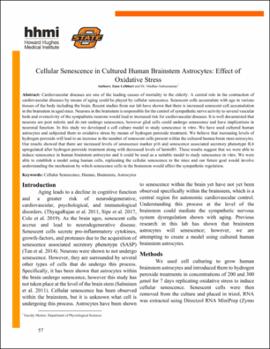| dc.contributor.advisor | Subramanian, Madhan | |
| dc.contributor.author | Leibhart, Zane | |
| dc.contributor.other | HHMI Life Science Freshman Research Scholars | |
| dc.date.accessioned | 2019-07-22T17:02:51Z | |
| dc.date.available | 2019-07-22T17:02:51Z | |
| dc.date.issued | 2019-04-27 | |
| dc.identifier | oksd_hhmi_2019_leibhart | |
| dc.identifier | oksd_hhmi_2019_leibhart_poster | |
| dc.identifier.citation | Leibhart, Z., & Subramanian, M. (2019, April 27). Cellular senescence in cultured human brainstem astrocytes: Effect of oxidative stress. Paper presented at the HHMI Life Science Freshman Research Scholars Symposium, Stillwater, OK. | |
| dc.identifier.uri | https://hdl.handle.net/11244/321024 | |
| dc.description.abstract | Cardiovascular diseases are one of the leading causes of mortality in the elderly. A central role in the contraction of cardiovascular diseases by means of aging could be played by cellular senescence. Senescent cells accumulate with age in various tissues of the body including the brain. Recent studies from our lab have shown that there is increased senescent cell accumulation in the brainstem in aged mice. Neurons in the brainstem is responsible for the control of sympathetic nerve activity to several vascular beds and overactivity of the sympathetic neurons would lead to increased risk for cardiovascular diseases. It is well documented that neurons are post mitotic and do not undergo senescence, however glial cells could undergo senescence and have implications in neuronal function. In this study we developed a cell culture model to study senescence in vitro. We have used cultured human astrocytes and subjected them to oxidative stress by means of hydrogen peroxide treatment. We believe that increasing levels of hydrogen peroxide will lead to an increase in the number of senescent cells present within the cultured human brain stem astrocytes. Our results showed that there are increased levels of senescence marker p16 and senescence associated secretory phenotype IL6 upregulated after hydrogen peroxide treatment along with decreased levels of laminB1. These results suggest that we were able to induce senescence in human brainstem astrocytes and it could be used as a suitable model to study senescence in vitro. We were able to establish a model using human cells, replicating the cellular senescence in the mice and our future goal would involve understanding the mechanism by which senescence cells in the brainstem would affect the sympathetic regulation. | |
| dc.description.sponsorship | Howard Hughes Medical Institute Science Education Program | |
| dc.format | application/pdf | |
| dc.language | en_US | |
| dc.publisher | Oklahoma State University | |
| dc.rights | In the Oklahoma State University Library's institutional repository this paper is made available through the open access principles and the terms of agreement/consent between the author(s) and the publisher. The permission policy on the use, reproduction or distribution of the article falls under fair use for educational, scholarship, and research purposes. Contact Digital Resources and Discovery Services at lib-dls@okstate.edu or 405-744-9161 for further information. | |
| dc.title | Cellular senescence in cultured human brainstem astrocytes: Effect of oxidative stress | |
| osu.filename | oksd_hhmi_2019_leibhart.pdf | |
| osu.filename | oksd_hhmi_2019_leibhart_poster.pdf | |
| dc.description.department | Physiological Sciences | |
| dc.type.genre | Research report | |
| dc.type.genre | Presentation | |
| dc.type.material | Text | |
| dc.subject.keywords | cellular senescence | |
| dc.subject.keywords | human | |
| dc.subject.keywords | brainstem | |
| dc.subject.keywords | astrocytes | |

